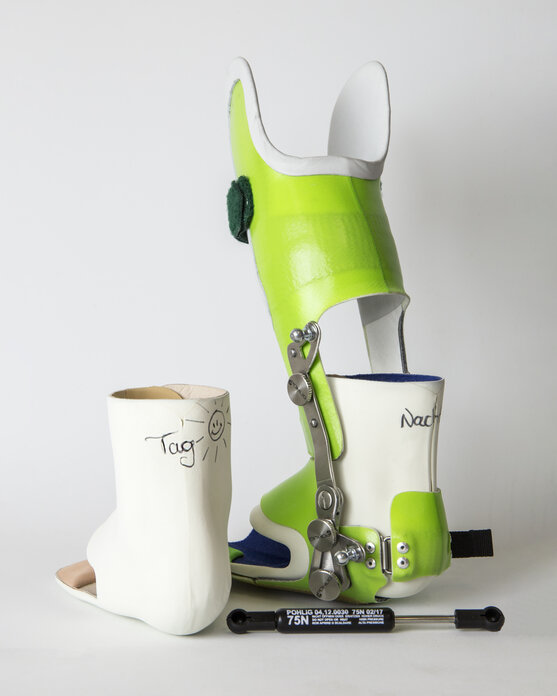An orthosis compensates for physical deficits, supports joints and protects them from relapse and misalignment.
We train you in the daily use of your orthosis.
Make an appointment over the phone or send us a message!

Aids for protecting and supporting
Orthotic treatment of the lower extremities
A properly fitted orthosis compensates for deficits, supports joints, and slows down or prevents the progression of joint deformities. Successful orthotic treatment of the lower extremities achieves gentle correction and stabilization of the affected foot or leg, all the while maintaining the highest level of function possible.
Depending on the deformity, orthoses can be used short-term or permanently. In order to limit unwanted movement or correct skeletal deformities, orthoses, in contrast to flexible bandages, are usually made of stronger materials like plastic. Orthoses can also offer support post-surgery by providing targeted stabilization and controlling range of motion of the joints. This facilitates the functional development of the hand or arm.
Treatment solutions
Orthoses for the lower extremities
We will manufacture an individual orthosis for you specifically tailored to your foot deformity or particular ailment. The spectrum of our orthotic treatment solutions is extremely broad. Certain orthoses make sure that the leg or foot is held in the correct position.
In case of paralysis, an orthosis can even help you take your first steps again (C-Brace®). Here are the most common types of orthoses:
(TRRO)
The ring-shaped foot socket reliably fixes the foot in the orthosis.
Initially, the CRRO was designed for correction of club foot.
(AFO)
The AFO is a dynamic orthosis that extends over the ankle joint.
The foot and lower leg sections are connected to one another by a joint.
The knee ankle foot orthosis has a movable ankle and knee joint.
The C-Brace® is an intelligent orthosis system that supports you in paralysis of the musculature connected to the knee.
The PHAO holds the hips in the medically required bracing position.

The PowerHip® transfers power from the legs to the hips.

The Mollii Suit is a full body orthosis for relaxing spastic muscles, activating weak muscles and reducing associated pain.

A key prerequisite for a successful orthotic treatment is consistent use of the device. This can only be achieved if you fully accept your finger, hand, or arm orthosis and wear it consistently in everyday life. To make the devices as comfortable as possible for you to wear, we produce orthoses that are highly functional and visually appealing.
We make sure to use light materials, so that the weight of the device does not cause any additional impairment. We also offer a wide range of different colors and designs for all orthoses so you can customize them to your liking.

Orthoses are generally only prescribed after an in-depth examination by a physician. Ideally, the choice of the appropriate device should always be made in collaboration with a physician, physiotherapist and orthopedic technician.
We are very keen to ensure this interdisciplinary cooperation. Teamwork plays a crucial role in the care of children with orthopedic aids. All participants are in the same boat. After all, optimum treatment results can only be achieved if doctors, orthopedic technicians, therapists, patients and parents all work together.

Let yourself be inspired! We accompany many interesting patients during their Pohlig appointment and give you personal insights.

For those who want to delve even deeper into the matter, we have a suitable video for almost every supply area.

Take a look behind the scenes at Pohlig and find out about diagnoses and our innovative aid solutions!

The Pohlig system
To ensure that an orthosis fulfills its function, the orthopedic technician adapts it individually to the child's body. This is the only way to ensure the best possible state-of-the-art care.
Thinking of the body as different segments is very effecitve when planning orthotic treatment. Only once the individual levels of the body have been discussed on an interdisciplinary basis can the therapeutic goal and design specifications of the orthosis be identified and defined. In practice, this means that we proceed from top to bottom (e.g. from hip to knee to ankle) and define the corrective measures step by step.
With the Pohlig system, a system in which the individual orthosis elements are put on separately, we can accommodate even the most complex misalignments. The POHLIG system offers the option for isolated stretching, bending, and rotation of the extremities, and thus enables a targeted therapy.
Static or dynamic?
Static orthoses are intended to fix affected joints in their correction position. Dynamic orthoses, on the other hand, apply force to correct malpositions (such as shortening of the tendons) by such means as spring hinges or gas springs.
Different designs can be selected depending on the clinical picture and characteristics (e.g. ICP, AMC, plexus paralysis, radial aplasia, etc.):
- dynamic joints for flexion, extension, pronation or supination
- different closure systems
- adapters for the application of individual parts of the orthosis
Static and dynamic orthoses are often worn at night. At night, the affected limb can be fixed or corrected over a long period of time. More functional orthoses are usually made for daytime use.

Instructions
How to clean a liner?
A soft-shell liner is basically the inner shoe of an orthosis. It is made of soft leather and stabilizes the foot in the orthosis.
It is important that you air out your liner regularly. Only if absolutely necessary, wipe the soft-wall liner with a damp cloth. We’ll show you how to do it!


